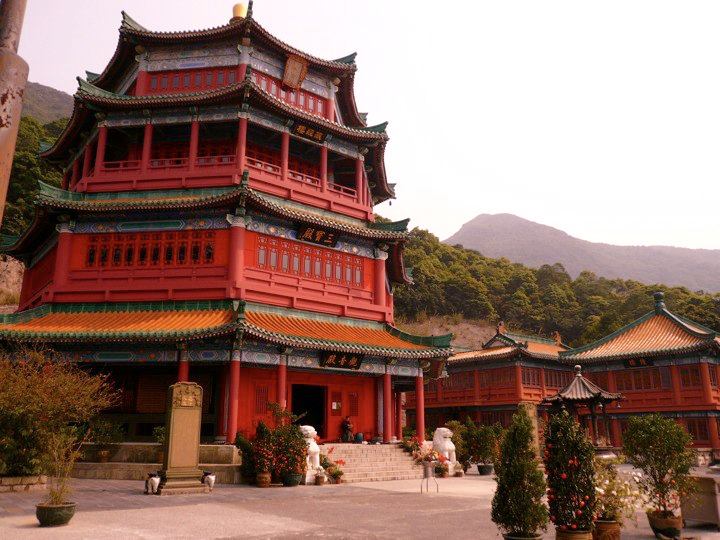Guan Yin Temple. From Planet Lantau (see their temple photo gallery here)
The first thing a visitor perceptive in Mahayana aesthetics notices at Guan Yin (or Kwun Yam, officially) Temple on Lantau Island, Hong Kong, is the pervasiveness of Huayan symbolism and imagery in the original hall, which was built in 1910, and the top level of the Summer Palace-styled main pagoda. In the former, the central shrine is dedicated to an image of Vairocana Buddha, the central Buddha of the Avatamsaka Sutra (Huayan jing or Flower Ornament Scripture).
In the latter, which houses the Thousand-Buddha Hall, a circular, dazzling host of miniature Buddhas surround images of the Five Wisdom Buddhas: Amitabha faces west, Akshobhya faces east, Amoghasiddhi faces north, and Ratnasmbhava faces south. Rising above them all is, once more, Vairocana, who wears a diadem indicating his status as the embodiment of the Dharmakaya (the universal body of truth shared by all enlightened beings) itself.
Yet my preceptor and former abbot of Guan Yin Temple, like so many across China and East Asia, always invoked the name of the Buddha of the Western Paradise, reciting the name of “Amituofo” or chanting the liturgy of “Namo Amituofo.” He understood, as most masters do, that the Mahayana sutras point the way to the most profound yet simple reality of the Dharma in this world: enlightenment in one act of faith. The extinguishing of cyclical suffering and the liberation of all beings through a single affirmation.
Huayan does not exist as an institutional “school.” Rather, it is like a fine membrane that permeates all the schools of Chinese Mahayana Buddhism. I personally came to Buddhism after being awestruck by the vision of the universe that the Avatamsaka Sutra offered. It helped me to see the cosmic interconnectedness, interpenetration, and sheer oneness of all the Buddha-fields and our tiny blue and green planet of suffering. When I look back retrospectively on my spiritual search, I see that accepting the Huayan worldview provided the doctrinal understanding necessary to align my practice with the Pure Land invocation of “Namo Amitabha.”
After all, it is the Aspiration of Samantabhadra himself, laid out in the Gandavyuha Sutra (the final book of the Avatamsaka), which concludes:
At the time of my death, may all obscurations be removed, that I may behold the Buddha of Infinite Light, and go to the Land of Ultimate Bliss.
In that blissful land, may I completely fulfil all of these aspirations, and benefit all beings as long as the universe remains.
Joyful there, in that blessed assembly of the Buddhas, may I be reborn like the holy ones, from an exquisite lotus, and may the Buddha Amitabha himself prophesy (vyakarana) my own Buddhahood.
There is no alternative, as far as my reading of this conclusion of the Avatamsaka and Gandavyuha goes, other than to conclude that Avatamsaka and Pure Land teachings are one.


Yeah, Amitabha’s Land of Utmost Bliss is the realization of Huayan ‘s worldview. The main point is how ordinary being can attain the Buddha-equivalent merits and virtues in order to be reborn in Amitabha’s Buddhaland. Amitabha Buddha says all MY merits and virtues contains in my NAME – Namo Amituofo. Whoever recites his NAME for rebirth in that land, they will be embraced with Amitabha’s light and receive Amitabha’s merits and virtues. In this respect, ordinary beings are ‘qualified’ to become an inhabitant in the Land of Bliss – easy and direct, as said by Bodhisattva Nagarjuna.
Namo Amitabha!